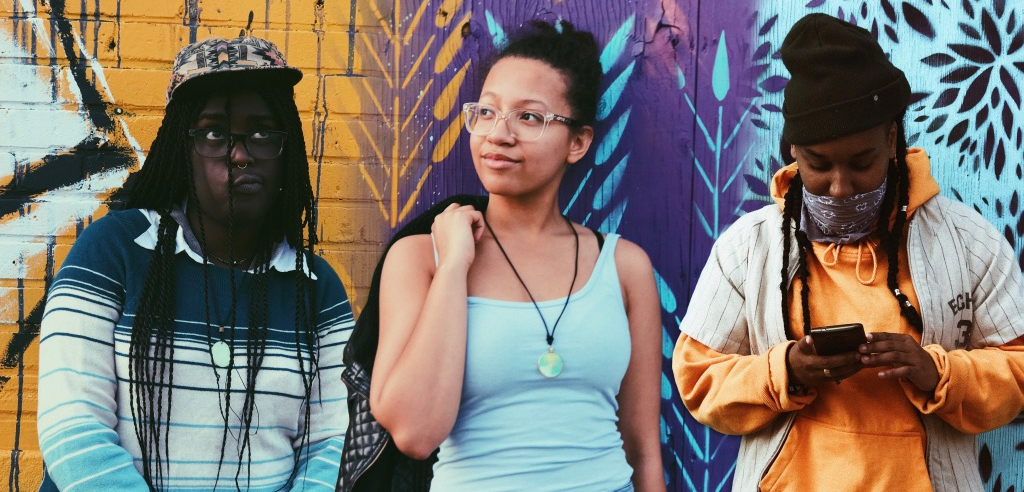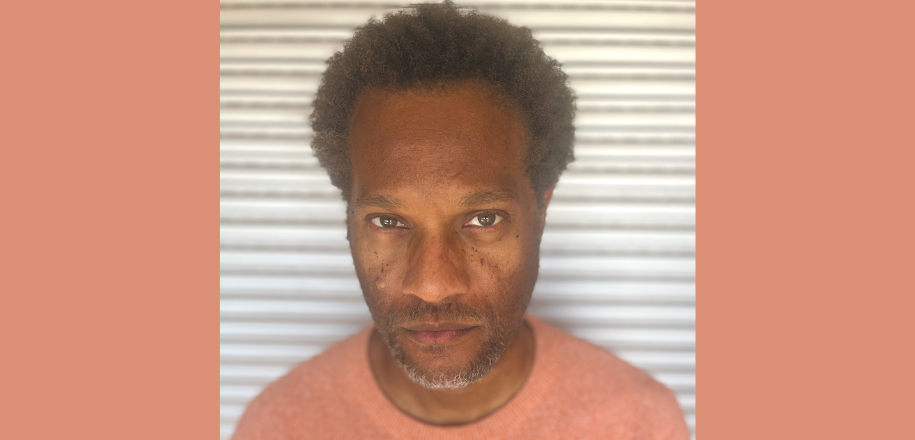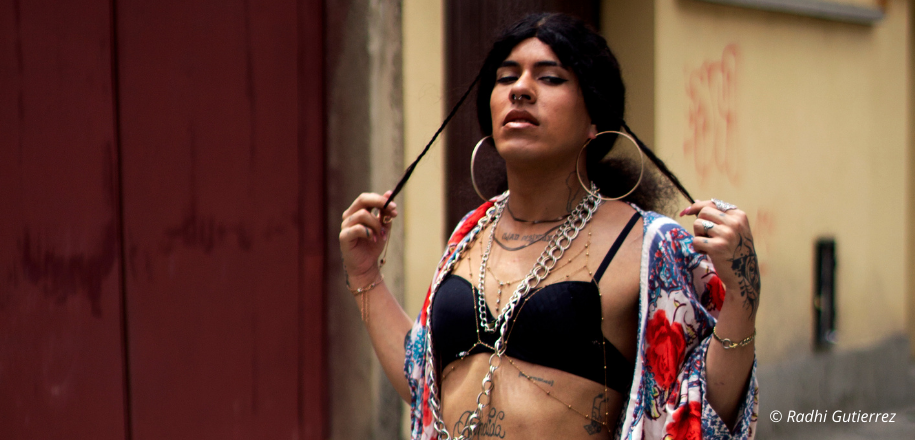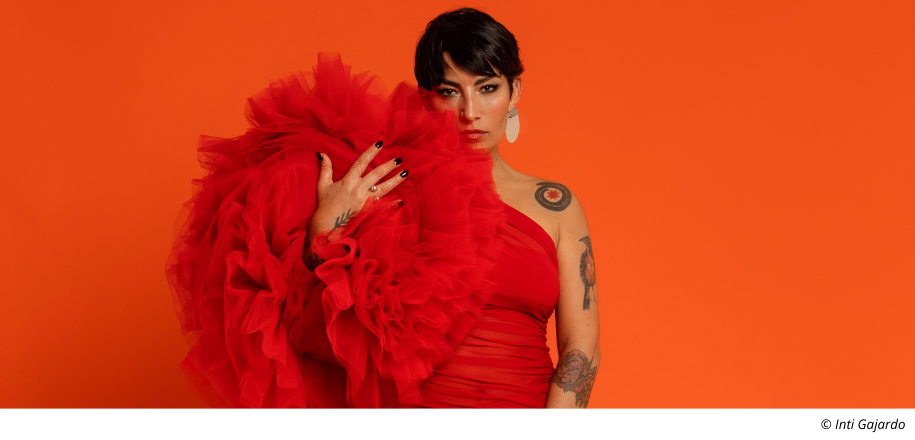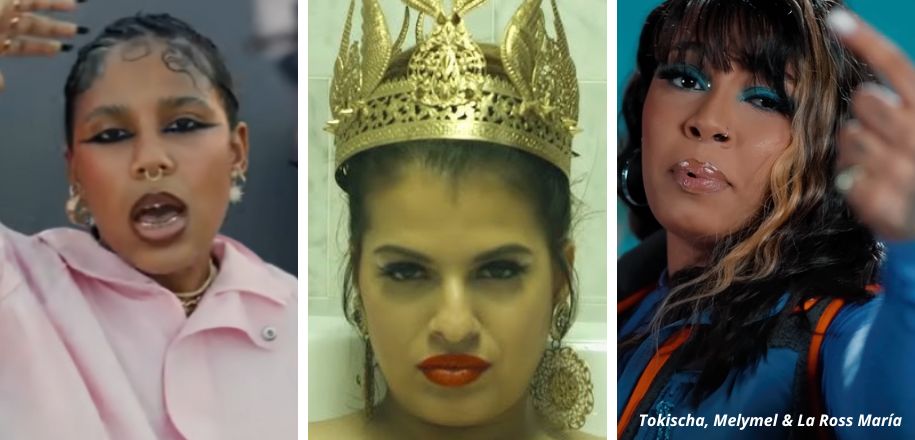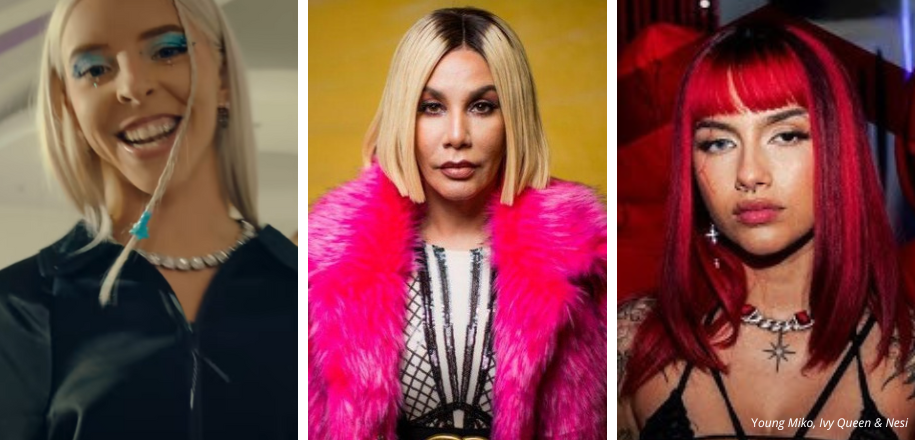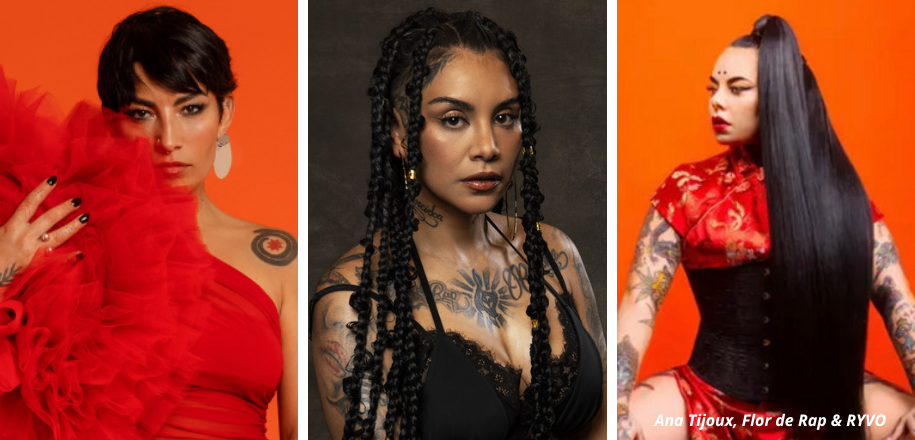Meet the Quebec rap band Strange Froots and the three Black and queer female rappers and singers: Mags (Senegalese-Ghanaian born in the US), Naïka Champaïgne (Quebec-Haitian) and SageS (Jamaican-Canadian). As the trio just released the video “The Wanderer”, they told us about the female rap scene in Montreal, how their identities impacts their music and their upcoming projects.
When and how did you discover hip hop?
Mags: I was exposed to hip hop at a relatively early age. I had two older siblings who watched BET, VH1 and MTV all the time, and had plenty of CDs for me to borrow. On the way to school every morning for as long as I can remember (either on the bus or my parent’s car), the station of choice always had hip hop and go-go music on. The first one I remember listening to wasCrazySexyCool by TLC; the first one I ever owned was Nellyville by Nelly, a gift from my dad for my 10th birthday (even if I’m pretty sure he only grabbed what he thought was popular at the time). From middle to high school most of the rap I listened to was Missy Elliott and Kid Cudi.
Naïka Champaïgne: I first got into hip hop through my mother and my brother, it was playing around the house and it was merely a part of my surroundings; artists like Missy, Ludacris, Biggie, Tupac…
SageS: I believe hip hop found me. Prior to the Strange Froots, I was primarily interested in pop, rock and alternative music. However, after joining NBS (NoBad Sound Studio) and subsequently meeting Mags and Naïka, I developed a new appreciation for the genre and am continuing to explore it in the music that I create.
When and how did you start rapping and which artists inspired you?
S: I appreciate hip hop because it is a powerful medium for artists. Historically, hip hop was used to voice the concerns of the black minority and to speak up against injustice, inequality, and the blatant truths of those times. I think it is a privilege to be able to do the same with my music.
NC: Before being in SF, I was a solo artist playing in certain lounges and bars and festivals for young adults called “Adofest”. It was me, myself and my guitar. I was singing some of my songs which are more acoustic, soul and jazzy/folk-ish and covers. Then, I started working with hip hop artists such as Dézuets d’Plingrés and Doc Mo. I actually made my first featuring and music video appearance with them.
M: I had a very short stint as the designated rapper in my best friend’s high school emo band (they wanted me to be like Mike Shinoda in Linkin Park) but I wasn’t into it. Later on during university (some time after moving to Montreal from the US) I discovered an event called Hip Hop Karaoke MTL, where people can sign up to perform their favorite hip hop track by heart (so no lyrics). I decided to give it a try, and having done theater and dance shows in high school, I found I had tapped into another side of my passion for performing. I definitely took a lot of cues from Missy, but later on I think Narcy influenced quite a bit of my flow.
How and when was Strange Froots founded?
M: The year our group was founded I was VP Marketing and Communications of the hip hop club at my university, and made a lot of artist friends through HHK, as well as the hip hop sociology class I had taken the year before (this is where the club was founded). One of my friends, Dr. MaD, was working at a youth center called NoBad Sound Studio (founded by our mentors Nomadic Massive), and invited me to a jam session. That’s where I met Naïka.
NC: NoBad Sound Studio is affiliated with La Maison des Jeunes Côte-des-Neiges, which is an open/free space for young teenagers from the ages 12-17 to have a safe place to have fun, do homework, do workshops of any kinds of activities; NBS Studio is the music center of that organization. It’s a place where kids can record beats and vocals for free. Workshops for songwriting and beatmaking are also available. Of us three, I was the first member there, I entered in February 2013; I heard about this studio by a friend of mine who is also a beatmaker, rapper and songwriter called Tshizimba. A year later in May, I met Mags at a meeting for new ideas to make NoBadSound progress and in June they decided to have a girls workshop because not a lot of girls entered the studio which is mainly into the hip hop scene.
S: I discovered NBS through my mother, who is friends with Kof (K.O.F.), an artist and former NBS counselor. He invited me to come back for a female-led workshop project, since there aren’t many girls at NBS. In fact, Naïka, Mags, and I were the only ones that showed up for it, so we decided to make a band instead.
What’s the story behind “The Wanderer”?
NC: Mags created the beat from “The Wanderer” a while ago, before she even met us. She sampled a beat from Cheikh Lo’s “Dokandeme” and it’s about a wanderer/immigrant. So when I wrote the lyrics to the song, the main verses, I was inspired by the movie 12 Years a Slave and racism, discrimination and inequality that is still very much present nowadays. It’s a song about how we Black people have suffered, still suffer, but we still dream about better lives and live for something better.
M: The sample itself is representative of my heritage. My father is Senegalese, and Cheikh Lo was one of many African artists I grew up hearing around the house. The story behind the music video differs quite a bit from the story of the song. The story in the video follows 3 people on different paths in relation to the African diaspora. One is about reclaiming what being “from the Motherland” means, another is about bridging cultural gaps within the same generation, and the third is more of an internal thing, self-decolonizing a bit.
You are three Black and queer women. How do your “Blackness” and “queerness” influence your music?
S: Being a queer, Black woman, I constantly feel a certain level of responsibility in displaying an authentic version of myself through my art that also honors these identities. Despite my being a relatively private person, it is important to me to share my truths publicly, if only to inspire, help, and/or amuse the people in my communities.
M: For me personally, I like to have nuance and subtle references to my own queerness by using gender neutral language in love songs or not always explicitly mentioning physical intimacy. Being on the ace spectrum, I’m used to having people assume being queer means also being hypersexual, which is often played up for jokes in media. While I might not care about a person’s gender if I’m attracted to them, I can still put emphasis on other aspects of being queer. As for the Black side of things, I always like to give a little shoutout to where my parents are from (Senegal and Ghana), and the fact that I’m a first-generation African-American, which I feel a lot of kids of immigrants can relate to. I also like to sample African music in the beats I produce (like in “The Wanderer” and “Afro Punkass”).
NC: There is a certain responsibility to fully grasps what it means to be all of these identities. There is a need to comprehend and feel how each of these oppressions shape me as an artist, how it crafts my art, my vision, and how people will perceive it.
Do you consider yourselves feminists? If so, what kind of feminism do you most relate to?
M: I do consider myself a feminist, and I relate mostly to issues of misogynoir, but intersectional feminism as a whole overall. There are a lot of times where even if I’m a queer Black woman, I have to always remember that I’m also coming from a place of cis, able-bodied, middle-upper class privilege with a degree. And I’ll be quick to call someone out on it even if they identify as things that I don’t; you can’t always be right because you are oppressed in certain ways, there’s always something to reconsider.
NC: I identify with Black feminism/intersectional feminism.
How is the female rap scene like in Montreal?
NC: It’s a big family; everyone knows one another or heard of one another. In terms of sound, it’s very tight and I would like to say raw, pure. People really seem to enjoy themselves, but if you don’t know the music genre, it’s so hard to find local artists. A normal citizen would not know where to look to find Montreal hip hop artist let’s say, unless they ARE interested in hip hop themselves.It started as a male dominated scene, for minorities, Black and Latinos, who lived in the struggle, the ghetto, in the white supremacy (still is) and how they wanted to address those injustices. You would think that women would also be a part of that right? As being the most oppressed human beings on the planet; but no, hip hop is seen as a macho scene, a macho environment, and masculine. And it still very is, sadly.
M: We have a lot of talented femcees, such as Hua Li, Sarahmée, the former members of Bad Nylon (Kayiri and Marie-Gold) just to name a few. A lot of times, the media likes to act as if we’re all “competing” in “a man’s world” when in reality, not only is the scene generally supportive and collaborative amongst girls, but a lot of us are friends in real life. This isn’t to say that there’s still a problem of under-representation in terms of, for example, race or Anglo vs. Franco among the female rappers.
S: I feel like there aren’t a lot of female collaborations in hip hop because hip hop is a very male-driven institution, and it’s very difficult for females to project an alternative to the misogynistic lyrics. But some women are doing just that, coming up with a different, less stereotypical version of hip hop. Women need to know that they can do hip hop their own way, which is exactly why Strange Froots was formed.
Who are your female role models and why?
M: I will always stan for Missy Elliott, because she’s always a decade ahead of the new wave, and her artistry was also so much fun and out of the box, not to mention I didn’t have a lot of role models with a similar body type to mine when I was growing up. Seeing a big dark skinned girl become an absolute legend really resonated with me. I also had a really huge Spice Girls phase that recently resurfaced, and after watching their documentaries it made me love them even more for their down-to-earthness and how important their friendship really was to them.
S: I was raised by an all-woman family. My mother and aunt, both multidisciplinary artists, inspired my love of the arts. My mother, Sylvia Stewart, an actress and stuntwoman, exposed me to the world of acting and stage performing, and my aunt Paula encouraged my passion for songwriting. As for musicians, there’s Jully Black, Ella Fitzgerald, Florence + The Machine…
NC: I would say Erykah Badu, Billie Holiday, Amy Winehouse, Nai Palm, Lauryn Hill, Ella Fitzgerald as well… I have too many.
What are your upcoming projects?
S: We’ll be spending this time working on new music. Having spent a few years on “The Wanderer” (from releasing the track on our titular EP back in 2014 to the music video we’ve worked on since our time in Senegal last summer) we’ve reached a turning point in the group. I look forward to situating our content in the present, showcasing who we are now as people, black and queer folk and what that means to us. Gotta keep it fresh
NC: New ideas in music, in creativity, in expressions. I want to challenge myself in those areas and also challenge the fans as well. It’s always good to challenge ourselves.
What do you think of Madame Rap? What should be changed or improved?
M: I grew up in the French system, having attended an international school with a majority of French kids (my best friend included), and watching channels like TV5, Canal+ and TRACE when visiting family in West Africa, so I had a small idea of what the content might be like when I first discovered it not too long ago, but I was pleasantly surprised! It’s really cool to see that you feature artists from everywhere and have bilingual content! That’s something you wouldn’t see a lot in Quebec.
Find Strange Froots on their website, Facebook, YouTube, Twitter and Instagram.
© Didi M’bow

